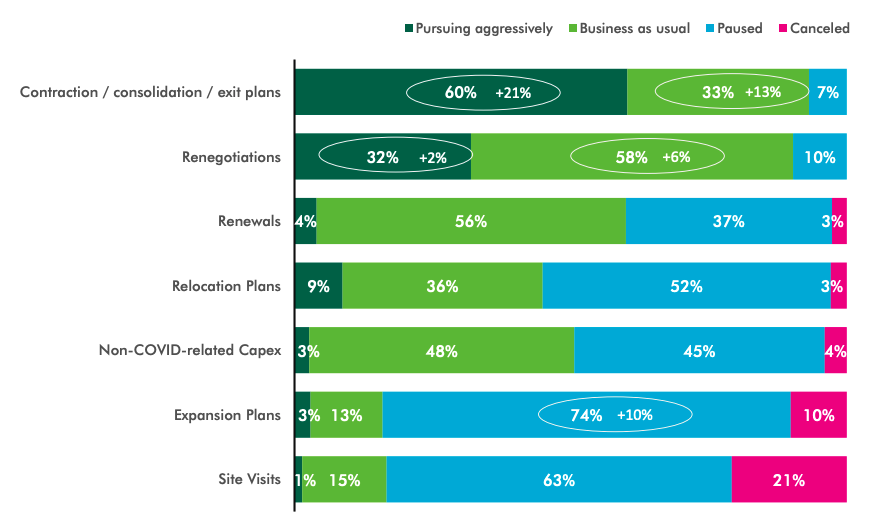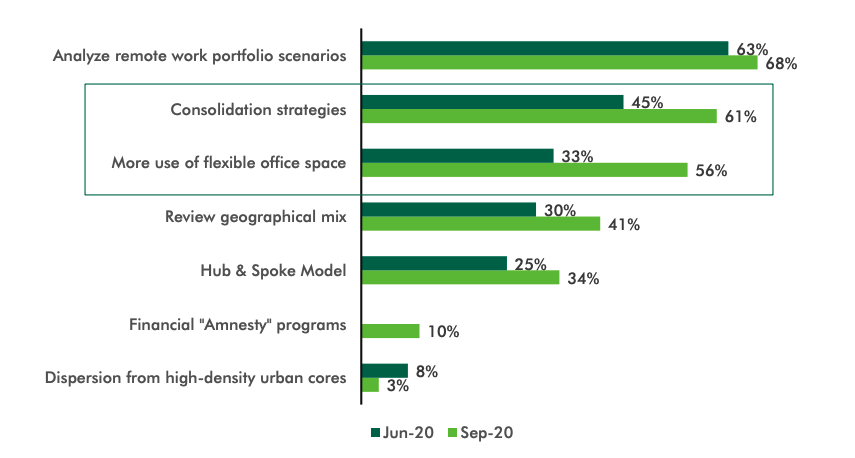How Much Office Space Do We Need?


The coronavirus has undoubtedly impacted demand for office space in the past year. Some of the effects will likely be temporary, while others could last for years to come.
Here’s a closer look at the data and predictions for how the coronavirus and flex space trends could impact short-term and long-term real estate demand.
How much office space do we need now?
We frequently hear about how widespread adoption of remote work has decreased the need for office space, but that’s only true for about a third of U.S. executives, according to a June survey by PwC.
Of the 1,200 survey respondents, half said they anticipated they’ll actually need more office space in the coming year. The PwC survey took place in late June, when COVID-19 vaccines were still in the early stages of development and the timeline was largely unknown. However, the question asked how they expected their corporate real estate needs would be different in three years — not just in the immediate future.
Many of the respondents anticipated needing more office space to implement physical distancing measures, while others cited growth as a primary or secondary reason.
Some said they would need less office space due to an increase in remote work, while others said their needs would stay about the same.
How much did they anticipate reducing or expanding their real estate? According to the survey data:
- 3% said they planned to reduce office space by more than 25%
- 12% said they planned to reduce office space between 15-25%
- 15% said they planned to reduce space between 5-15%
- 19% said their need for office space would stay about the same
- 26% said they planned to increase office space by 5-15%
- 16% said they planned in increase space by 16-25%
- 9% said they planned to increase space by more than 25%
The executives’ projected real estate needs seems to coincide with how often they expect employees to work in the office after the threat of COVID-19 has subsided.
According to a PwC survey of employees during that same time period, 68% said they would like to work in the office at least part of the time each week.
Not surprisingly, the top reason employees want to return to the office is to collaborate with others. Other reasons included not having access to equipment like printers, while 22% said it was difficult to do their jobs because their work hadn’t been digitized.
When do companies expect to reopen offices?
CBRE’s Future of the Office survey in September offers additional insights into the changing demand for office space, starting with when companies plan to reopen.
Globally, 21% of the companies who responded said they had already reopened the office, while 46% said they plan to reopen by the middle of 2021. Another 34% said their timeline would be even later.

Those waiting to reopen said their top reasons were concerns about putting employees at risk and employees feeling reluctant to return. Considerations about childcare also factored heavily into the decision.
Another CBRE survey of 10,000 employees mirrored the findings of the PwC survey, with less than a third of employees saying they wanted to be fully remote after the COVID crisis. The majority (57%) wanted to split their time between home and the office, while 16% said they wanted to work primarily or entirely in the office.
Is flex space the future?
Over half of executives who responded to the Future of the Office survey said they expected their workforce to be slightly or significantly less dependent on the physical office environment in the future. However, that doesn’t mean they don’t believe it’s important. While employees may not need the office to do their jobs each day, respondents said they see it as a critical hub for building community, collaborating, and attracting and engaging talent.
As the role of the office evolves, so should office design. Many organizations are moving away from assigned seats in favor of flexible workspace designs like activity-based working and office neighborhoods. In the future, CBRE predicts we’ll see office design evolve even further to favor collaborative areas over private, individual spaces.
These flex space strategies can lead to considerable cost savings. Consider how much your organization could save if you eliminated dedicated desks and adopted hot desking or office hoteling.
Or, if your company is experiencing a lot of growth, how much could you save by leasing coworking spaces in strategic areas rather than taking out a 15-year lease? If you have to close several small locations, it’s a much smaller loss than shutting down an entire corporate campus. Flex space also makes it easier to find diverse talent in different geographic locations. And it allows employees to live in more affordable areas without a lengthy commute to the center of a large metropolitan area.
It’s not surprising, then, that over half of corporate real estate leaders said they were considering using flexible office space strategies to minimize risk and uncertainty. And 82% said it’s something they will be looking for as they select buildings to lease in the future.
Like any good investor, they are looking to diversify their assets.
How are corporate real estate leaders adjusting their portfolios?
Many corporate real estate leaders believe COVID-19 will impact their organization’s portfolios for years to come. Eighty-seven percent of those surveyed said they expected to see either a modest or a significant decrease in real estate, while only 4% anticipate an increase.

After a year of uncertainty, corporate real estate leaders are managing risks in a variety of ways. While 50% of company executives said they planned to increase office space in the coming year, 60% of CRE leaders said they planned to “contract, consolidate, or exit” plans they previously had in place.
Additionally, 74% paused expansion plans, while 52% paused plans to relocate.
Other strategies include:

- Analyzing remote work portfolio scenarios
- Reviewing their geographical mix
- Using the Hub & Spoke model of establishing smaller offices where employees can collaborate closer to home
- Taking advantage of tax amnesty programs
What can real estate leaders do now to prepare?
These strategies require the ability to analyze real-time data on space utilization and costs.
That means going beyond basic occupancy and vacancy metrics. As a real estate leader, you need visibility into every aspect of your company’s operations.
For instance, you need to be able to see:
- How many employees are working in the office versus remotely, and how often
- How new physically distanced seating scenarios will impact maximum capacity
- The average square footage of space per employee
- The average desk utilization ratio
- The total cost of office space per employee
- How many employees use the assets and amenities you offer on any given day
iOFFICE’s space management software puts this information at your fingertips so you can make smarter decisions to optimize your office space and your real estate portfolio.
You can visualize your entire real estate portfolio with Google-style maps, zooming in by building, floor, or department.
You can see real-time space utilization using employee badge data or IoT sensors so you can plan to reduce or expand your office space based on actual demand.
And if you’re planning an office move or renovation, you can use drag-and-drop tools to map out different scenarios before you finalize them.
You can even see the impact of increasing the distance between spaces or assigning employees to alternating shifts with our space planning feature.
This helps you keep your workforce safe now while allowing you to take advantage of flexible office space strategies in the future.
Investing in the right real estate technology now will help you adjust your office space to keep up with your changing needs.
For quick tips on how to adjust your office space to navigate physical distancing and flexible work in the coming year, check out this cheat sheet.
